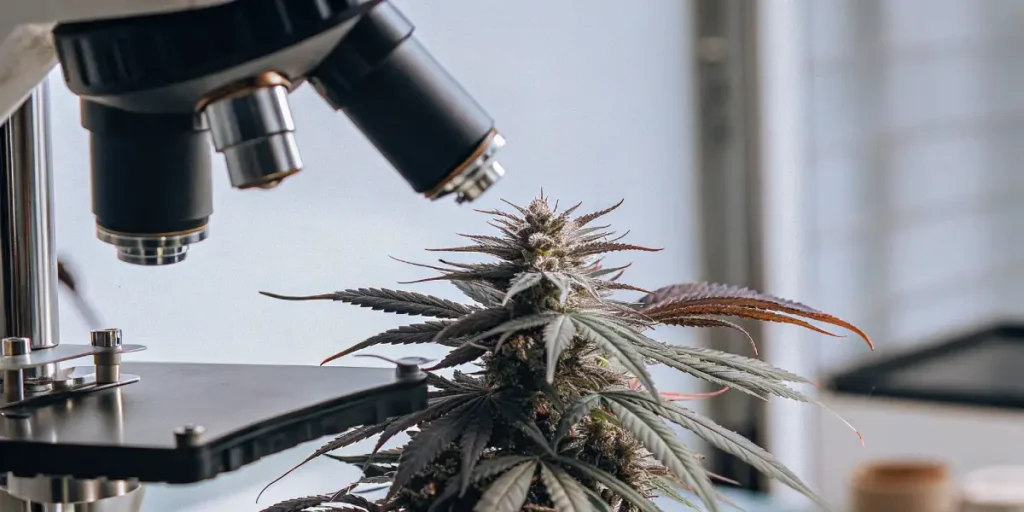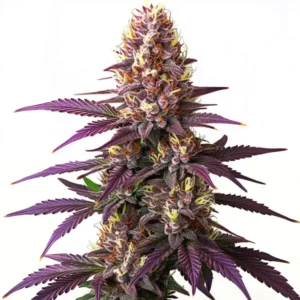
Amino Acid Synthesis in Cannabis
Amino acid synthesis in cannabis plays a crucial role in the plant’s growth and development. These organic compounds are the building blocks of proteins, essential for various biological processes. When growing cannabis, understanding how amino acids are synthesized can lead to healthier plants and better yields.
The biosynthesis of amino acids in cannabis involves several pathways. These pathways ensure that the plant can create the necessary amino acids for protein synthesis. This is important because proteins are involved in almost every function of the plant, from structure to metabolism.
Recommended Strains
OG Kush
|
|
THC | 20% - 24% (Medium) |
|
|
Type | Feminized |
|
|
Yield | Medium |
|
|
Phenotype | 55% Indica / 45% Sativa |
Blue Dream
|
|
THC | 17% - 24% (Medium) |
|
|
Type | Feminized |
|
|
Yield | High |
|
|
Phenotype | 50% Indica / 50% Sativa |
By enhancing amino acid synthesis in cannabis cultivation, growers can improve the overall health and productivity of their plants. This involves providing the right nutrients and conditions to support the natural pathways of amino acid production.
The Basics of Amino Acid Synthesis in Cannabis
Cannabis plants synthesize amino acids through a series of chemical reactions. These reactions occur within the cells, utilizing available nutrients. The cannabis amino acid synthesis pathways include several steps that transform simple compounds into complex amino acids.
Key elements in these pathways are nitrogen, carbon, hydrogen, and oxygen. These elements are absorbed from the soil or through fertilizers. Once inside the plant, they are used to create amino acids, which then contribute to protein synthesis.
Knowing the cannabis amino acid synthesis pathways allows growers to optimize their cultivation techniques. By ensuring that these pathways operate efficiently, plants can better utilize nutrients, resulting in stronger growth and higher yields. This knowledge is essential for both amateur and professional cultivators looking to maximize the potential of their crops.
The biosynthesis of amino acids in cannabis is also influenced by genetic factors. Different strains may have varying efficiencies in these pathways, which can affect their growth rates and final yield. Selecting strains with robust amino acid synthesis capabilities can be a key factor in achieving successful cultivation outcomes.
Key Amino Acids in Cannabis
Some of the most important amino acids involved in cannabis protein synthesis include glutamine, arginine, and lysine. Glutamine is crucial for nitrogen transport, helping the plant convert nitrogen into a usable form. Arginine plays a role in cell division and growth, essential for robust plant development.
Lysine, on the other hand, is vital for protein formation and hormone production. These amino acids not only support the plant’s growth but also enhance its resistance to stress. In stressful conditions, such as extreme temperatures or pest attacks, amino acids help the plant maintain its functions.
Besides to these, other amino acids like methionine and cysteine are also significant in the role of amino acids in cannabis growth. Methionine is involved in the synthesis of other essential molecules, while cysteine contributes to antioxidant defense mechanisms within the plant. Together, these amino acids ensure that the plant can thrive under various environmental conditions.
The balance and availability of these amino acids can significantly affect the plant’s ability to respond to environmental challenges. By understanding the specific roles of amino acids involved in cannabis protein synthesis, growers can tailor their nutrient strategies to support optimal plant health and productivity.
Promos & Deals
Enhancing Amino Acid Synthesis in Cannabis Cultivation
To boost amino acid synthesis in cannabis, growers should focus on soil health and nutrient availability. Providing a balanced fertilizer that includes nitrogen, phosphorus, and potassium can support the plant’s synthesis pathways.
Additionally, incorporating organic matter such as compost can enhance soil quality. This not only improves nutrient uptake but also supports beneficial microbial activity, essential for efficient amino acid biosynthesis in cannabis.
Enhancing amino acid synthesis in cannabis cultivation also involves ensuring that the plants have access to adequate water and light. These factors can influence the efficiency of the biosynthesis pathways, as they are integral to the plant’s metabolic activities. Proper irrigation and lighting can thus complement nutrient management to promote healthy growth.
Moreover, employing sustainable agricultural practices can contribute to long-term soil health and nutrient availability. Techniques such as crop rotation and the use of cover crops can help maintain soil fertility, which is crucial for the continuous support of amino acid synthesis in cannabis.

Practical Tips for Growers
Regularly testing soil can help determine if the nutrients necessary for amino acid synthesis are present. Adjusting nutrient levels based on test results ensures that plants have everything they need for optimal growth.
Using strains like OG Kush from Blimburn Seeds can also be advantageous. This strain thrives with proper amino acid supplementation, leading to dense buds and high yields.
Another effective strategy is to implement integrated pest management (IPM) practices. By minimizing pest pressures, plants can allocate more resources to growth and amino acid synthesis, rather than defense mechanisms. This holistic approach can contribute to a more efficient and productive cultivation process.
Additionally, keeping detailed records of cultivation practices and plant responses can help growers refine their strategies over time. By analyzing which practices yield the best results, cultivators can continuously improve their approach to enhancing amino acid synthesis in cannabis.
The Function of Amino Acids in Cannabis Growth
Amino acids are not just building blocks but also play a significant role in the plant’s overall physiology. They are involved in enzyme production, which drives many of the plant’s metabolic activities.
Moreover, amino acids contribute to chlorophyll formation, the green pigment essential for photosynthesis. Efficient photosynthesis results in better energy production, supporting robust growth and development.
The role of amino acids in cannabis growth extends beyond basic metabolic functions. They are also involved in signaling pathways that regulate plant responses to environmental stimuli. This ensures that the plant can adapt to changes in its surroundings, such as fluctuations in temperature or light intensity.
Furthermore, amino acids play a part in the synthesis of secondary metabolites, including terpenes and cannabinoids. These compounds are crucial for the plant’s interaction with its environment, influencing characteristics such as aroma, flavor, and therapeutic properties.
Real-Life Application in Cultivation
For growers cultivating the Blue Dream strain from Blimburn Seeds, ensuring a rich supply of amino acids can lead to vibrant growth. Blue Dream is known for its vigorous growth and large yields, which are supported by an efficient amino acid synthesis process.
Incorporating amino acid supplements into the feeding regimen can further enhance plant health. This is especially beneficial in hydroponic systems where natural nutrient cycles might be limited.
Real-life applications of amino acid synthesis in cannabis cultivation also involve the use of bio-stimulants. These products can enhance the efficiency of amino acid synthesis pathways, leading to improved growth performance. Bio-stimulants can be particularly valuable in organic cultivation systems where synthetic inputs are minimized.
Additionally, sharing knowledge and experiences among the cultivation community can drive innovation and improvement in amino acid synthesis practices. By exchanging successful techniques and observations, growers can collectively advance the understanding and application of amino acid synthesis in cannabis.

FAQs
What are amino acids, and why are they important for cannabis?
Amino acids are organic compounds that form proteins. In cannabis, they are crucial for growth, development, and stress resistance. They help build proteins, which are necessary for various plant functions, including enzyme activity and structural integrity.
Without sufficient amino acids, cannabis plants may exhibit stunted growth and reduced yields. Ensuring that plants have access to the nutrients needed for amino acid synthesis can promote healthier, more productive plants.
The importance of amino acids in cannabis extends to their role in enhancing the plant’s resilience to abiotic stress. By supporting cellular integrity and function, amino acids help the plant withstand conditions such as drought or nutrient deficiencies.
Furthermore, amino acids are involved in the detoxification processes within the plant. They aid in the neutralization of harmful compounds, ensuring that the plant remains healthy and capable of optimal growth and development.
How can I increase amino acid synthesis in my cannabis plants?
Improving soil quality and nutrient availability is key. Use a balanced fertilizer and consider organic matter to enhance soil health. Regular soil testing can help you adjust nutrient levels as needed.
Additionally, foliar feeding with amino acid-rich solutions can provide direct nutrient access. This method allows plants to absorb essential compounds quickly, supporting rapid growth and development.
Besides to these practices, choosing the right strain can also impact the efficiency of amino acid synthesis in cannabis. Some strains are naturally more efficient at synthesizing amino acids, leading to improved growth and yield outcomes.
Implementing a comprehensive nutrient management plan that incorporates both macro and micronutrients can further support amino acid synthesis. This ensures that all the necessary elements for biosynthesis are available to the plant.
Can amino acid synthesis impact the flavor and potency of cannabis?
Yes, amino acid synthesis can influence both flavor and potency. Amino acids contribute to the formation of terpenes and cannabinoids, compounds responsible for the plant’s aroma and effects.
By optimizing amino acid synthesis, growers can enhance the quality of their cannabis. This results in more flavorful and potent buds, which are highly desirable in the market.
Flavor enhancement through amino acid synthesis is largely due to the increased production of terpenes. These aromatic compounds give cannabis its distinctive scent and taste, which are important factors in consumer preferences.
Potency is also affected by the efficiency of amino acid synthesis, as it impacts the production of cannabinoids. Ensuring robust amino acid pathways can lead to higher concentrations of these active compounds in the final product.
Do all cannabis strains benefit equally from enhanced amino acid synthesis?
While all cannabis strains can benefit from efficient amino acid synthesis, some strains may respond more positively than others. Strains like OG Kush and Blue Dream are known for their robust growth and can exhibit noticeable improvements.
It’s important for growers to experiment with different strains and observe how they respond to amino acid supplementation. This allows for tailored cultivation practices that maximize the potential of each strain.
Factors such as genetic makeup and environmental conditions can influence how a particular strain benefits from amino acid synthesis. By knowing these variables, growers can make informed decisions about which strains to cultivate under specific conditions.
Additionally, breeders can use this information to develop new strains with enhanced amino acid synthesis capabilities, leading to improved growth performance and yield potential in varied cultivation environments.
Are there any specific environmental conditions that affect amino acid synthesis in cannabis?
Yes, environmental factors such as temperature, light, and humidity can impact amino acid synthesis. Optimal conditions can enhance synthesis efficiency, while extreme conditions may disrupt these processes.
Growers should aim to provide a stable environment that supports healthy plant development. Temperature control, adequate lighting, and proper ventilation are crucial for maintaining the conditions conducive to amino acid synthesis.
Temperature fluctuations can affect enzyme activity involved in the biosynthesis of amino acids in cannabis. Maintaining a consistent temperature range ensures that these enzymatic processes occur efficiently, contributing to overall plant health.
Light intensity and duration also play a role in amino acid synthesis. Adequate light exposure supports photosynthesis, which in turn provides the energy needed for amino acid production and other metabolic activities within the plant.




















